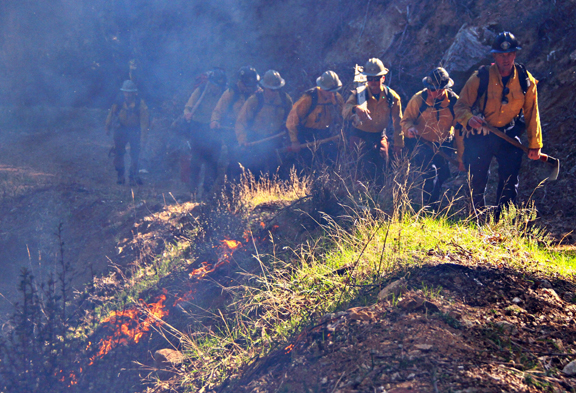
Crews work a prescribed burn, one tool for fire fuel management.
By Charly SHELTON
This is the second article in a three-part series on fire and fuel management in the local area.
Last week, we learned about the restorative necessity of wildland fires and the management techniques of native Californians for thousands of years before the arrival of Europeans. In the modern day, the U.S. Forest Service oversees fire fuel management in the vast swaths of protected natural landscape like our local Angeles National Forest. Fighting fire with fire is still one of the best tools used to prevent massive blazes; by setting small, easily controlled fires that are surrounded before they are ignited, a vast swath of land can be cleared quickly. That wildland will reap the benefits of having a cleansing fire without the danger of the blaze getting out of hand and putting houses in jeopardy. But it’s not the only tool available for fire fuel management.
“As we plan projects, we start out looking at our overall Land Management Plan. Most of the emphasis around our Hazard Fuels Program is for community protection, and that has a number of elements,” said Robert Garcia, Forest Fire Management officer/fire chief for the USFS. “For each of our projects, we have a whole array of tools to meet those objectives. Obviously prescribed fire is one of those tools, but that tool can also be limited by weather and field conditions such as drought. We also [consider] other options in our planning to meet those goals. We do a lot of mechanical treatment – the use of hand treatment [in removing fallen detritus] – there’s brush cutting and [chipping up fallen trees] with heavy equipment, so those are some of the other tools that we look at.”
But for a prescribed burn to occur, the conditions must be just right. In choosing a site to do a controlled burn, Garcia said many factors are looked at and prioritized – main commuter roads that may be evacuation routes in a larger wildfire, infrastructure like power lines and communications towers, things that would not be easy to defend when a large blaze breaks out elsewhere. With a site chosen, the conditions on the ground must also be ideal.
“We’re limited to the number of days that we’re actually prescribed that we can put fire to the ground, that once we light it it won’t get up and run away and be an escape fire,” said Mike Strawhun, assistant fire management officer/deputy fire chief for the USFS. “On the wetter side, that it won’t achieve our ultimate goal of reducing the percentage of fuel on the ground. So that’s one thing the drought has truly done to us is narrow the window where we can use fire on the ground.”
Drought and fire go hand-in-hand. Prescribed burns become more unpredictable in drought conditions and can pose a larger danger than benefit with so much fire fuel around. The drought of the last several years not only made fire conditions more widespread across the state but also made mitigation more challenging as well. An increased danger and a reduced capacity to control the risk made for a tough fire season.
“We’ve had conversations in recent years where we’re seeing higher tree mortality. Drought makes the vegetation a little bit more susceptible to insect infestation and disease,” Garcia said, “Where you see high tree mortality or high levels of dead vegetation, if we’re doing prescribed fire, for example, we take a look at [the] new fuel composition. That can change both the risk to the defense zone that we’re looking at and it can also change the parameters in terms of how we treat that piece of ground.”
Garcia added that dead standing vegetation is a lot more volatile to manage in a prescribed burn.
“So we take that into account as far as the type of contingency plans we have in place, the type of heat intensity that’s going to burn things like that,” he said. “So it definitely has a way to change both the planning and also the execution of those projects.”
